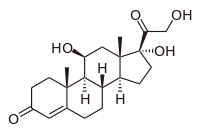
Photo from wikipedia
Introduction: Familial glucocorticoid deficiency (FGD) is a rare autosomal recessive potentially life-threatening condition, characterized by glucocorticoid deficiency, preserved aldosterone/renin secretion, and secondary rise in plasma adrenocorticotropic hormone level. This occurs… Click to show full abstract
Introduction: Familial glucocorticoid deficiency (FGD) is a rare autosomal recessive potentially life-threatening condition, characterized by glucocorticoid deficiency, preserved aldosterone/renin secretion, and secondary rise in plasma adrenocorticotropic hormone level. This occurs due to either mutation in adrenocorticotropic receptor (25%, FGD Type-1) or in the MC2 receptor accessory protein (15%–20%). However, in about 50% patients, no identifiable mutations have been identified. Clinically, it manifests with weakness, fatigue, weight loss, anorexia, nausea, vomiting, diarrhea, abdominal pain, hypoglycemia, and hypothermia. Progressive mucocutaneous pigmentation is a conspicuous presentation. Repeated hypoglycemia may result in seizure, persistent neurological, severe mental disability, and even sudden death. Standard therapy is oral glucocorticoids (10–15 mg/m2). Patients and Results: Two familial cases of FGD were put on progressively increasing doses of oral glucocorticoids (10 mg, 15 mg, and 20 mg/m2/day, each for 6 weeks) to achieve the best response without any adverse effects. One patient had excellent improvement with 15 mg/m2/day, and another required 20 mg/m2/day. The latter patient had excellent overall improvement with only moderate improvement in pigmentation. Conclusion: Glucocorticoids replacement with optimum dose is necessary in FGD to promote physical and neurological growth and to prevent adrenal crises, hypotension, hypoglycemia, and sudden death. Higher dose than mentioned in literature (15 mg/m2/day) may be required in selected cases. Mucocutaneous pigmentation may require even higher dose than we used. More studies are required.
Journal Title: Indian Journal of Dermatology
Year Published: 2017
Link to full text (if available)
Share on Social Media: Sign Up to like & get
recommendations!